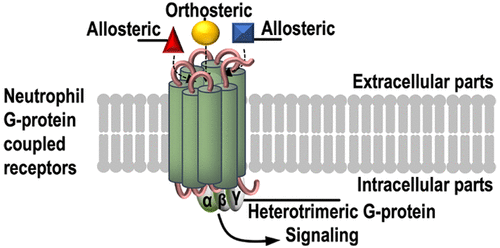当前位置:
X-MOL 学术
›
ACS Pharmacol. Transl. Sci.
›
论文详情
Our official English website, www.x-mol.net, welcomes your feedback! (Note: you will need to create a separate account there.)
Neutrophil Signaling That Challenges Dogmata of G Protein-Coupled Receptor Regulated Functions.
ACS Pharmacology & Translational Science Pub Date : 2020-03-11 , DOI: 10.1021/acsptsci.0c00004 Claes Dahlgren 1 , André Holdfeldt 1 , Simon Lind 1 , Jonas Mårtensson 1 , Michael Gabl 1 , Lena Björkman 1 , Martina Sundqvist 1 , Huamei Forsman 1
ACS Pharmacology & Translational Science Pub Date : 2020-03-11 , DOI: 10.1021/acsptsci.0c00004 Claes Dahlgren 1 , André Holdfeldt 1 , Simon Lind 1 , Jonas Mårtensson 1 , Michael Gabl 1 , Lena Björkman 1 , Martina Sundqvist 1 , Huamei Forsman 1
Affiliation

|
Activation as well as recruitment of neutrophils, the most abundant leukocyte in human blood, to sites of infection/inflammation largely rely on surface-exposed chemoattractant receptors. These receptors belong to the family of 7-transmembrane domain receptors also known as G protein-coupled receptors (GPCRs) due to the fact that part of the downstream signaling relies on an activation of heterotrimeric G proteins. The neutrophil GPCRs share significant sequence homologies but bind many structurally diverse activating (agonistic) and inhibiting (antagonistic) ligands, ranging from fatty acids to purines, peptides, and lipopeptides. Recent structural and functional studies of neutrophil receptors have generated important information on GPCR biology in general; this knowledge aids in the overall understanding of general pharmacological principles, governing regulation of neutrophil function and inflammatory processes, including novel leukocyte receptor activities related to ligand recognition, biased/functional selective signaling, allosteric modulation, desensitization mechanisms and reactivation, and communication (cross-talk) between GPCRs. This review summarizes the recent discoveries and pharmacological hallmarks with focus on neutrophil GPCRs. In addition, unmet challenges are dealt with, including recognition by the receptors of diverse ligands and how biased signaling mediates different biological effects.
中文翻译:

嗜中性粒细胞信号,挑战G蛋白偶联受体调节功能的教条。
嗜中性粒细胞(人类血液中最丰富的白细胞)的激活以及募集到感染/炎症部位很大程度上取决于表面暴露的趋化因子受体。这些受体属于7跨膜结构域受体家族,也称为G蛋白偶联受体(GPCR),原因是部分下游信号传导依赖于异源三聚体G蛋白的激活。中性粒细胞GPCR具有显着的序列同源性,但结合许多结构多样的活化(激动)和抑制(拮抗)配体,范围从脂肪酸到嘌呤,肽和脂肽。中性粒细胞受体的最新结构和功能研究已获得有关GPCR生物学的重要信息。这些知识有助于对一般药理学原理的整体理解,调节中性粒细胞功能和炎症过程的调控,包括与配体识别,偏向/功能性选择性信号传导,变构调节,脱敏机制和再活化以及GPCR之间的交流(串扰)有关的新白细胞受体活性。这篇综述总结了以中性粒细胞GPCR为重点的最新发现和药理学标志。此外,还面临未解决的挑战,包括各种配体的受体识别以及偏向的信号传导如何介导不同的生物学效应。以及GPCR之间的交流(串扰)。这篇综述总结了以中性粒细胞GPCR为重点的最新发现和药理学标志。此外,还面临未解决的挑战,包括各种配体的受体识别以及偏向的信号传导如何介导不同的生物学效应。以及GPCR之间的交流(串扰)。这篇综述总结了以中性粒细胞GPCR为重点的最新发现和药理学标志。此外,还面临未解决的挑战,包括各种配体的受体识别以及偏向的信号传导如何介导不同的生物学效应。
更新日期:2020-04-23
中文翻译:

嗜中性粒细胞信号,挑战G蛋白偶联受体调节功能的教条。
嗜中性粒细胞(人类血液中最丰富的白细胞)的激活以及募集到感染/炎症部位很大程度上取决于表面暴露的趋化因子受体。这些受体属于7跨膜结构域受体家族,也称为G蛋白偶联受体(GPCR),原因是部分下游信号传导依赖于异源三聚体G蛋白的激活。中性粒细胞GPCR具有显着的序列同源性,但结合许多结构多样的活化(激动)和抑制(拮抗)配体,范围从脂肪酸到嘌呤,肽和脂肽。中性粒细胞受体的最新结构和功能研究已获得有关GPCR生物学的重要信息。这些知识有助于对一般药理学原理的整体理解,调节中性粒细胞功能和炎症过程的调控,包括与配体识别,偏向/功能性选择性信号传导,变构调节,脱敏机制和再活化以及GPCR之间的交流(串扰)有关的新白细胞受体活性。这篇综述总结了以中性粒细胞GPCR为重点的最新发现和药理学标志。此外,还面临未解决的挑战,包括各种配体的受体识别以及偏向的信号传导如何介导不同的生物学效应。以及GPCR之间的交流(串扰)。这篇综述总结了以中性粒细胞GPCR为重点的最新发现和药理学标志。此外,还面临未解决的挑战,包括各种配体的受体识别以及偏向的信号传导如何介导不同的生物学效应。以及GPCR之间的交流(串扰)。这篇综述总结了以中性粒细胞GPCR为重点的最新发现和药理学标志。此外,还面临未解决的挑战,包括各种配体的受体识别以及偏向的信号传导如何介导不同的生物学效应。

























 京公网安备 11010802027423号
京公网安备 11010802027423号